Orioles and catbirds – grape jelly addicts!!!!!
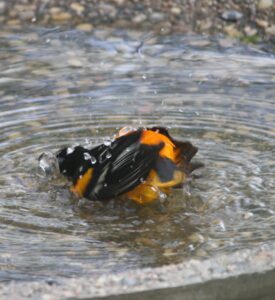
If you have been watching the bird bath cam livestream, you will have noticed that I moved the oriole feeder lower and closer to the bird bath. When I moved it, I was uncertain if the new location would work as it is now quite close to the bird bath which many birds besides the orioles use. I thought that maybe the orioles would become skittish and stay away. I completely underestimate their grape jelly addiction! In fact, Cleon and I have been laughing. We think the orioles would actually prefer to have the feeder placed even closer so they could step from the feeder right into the water! Moving this feeder so close to the bird bath did not bother one bird!
If you have been watching, you will have noticed Gray Catbirds and House Finches are also using that feeder. We think there are 2-3 pairs of orioles and possibly 2 more unmated males, 2-3 pairs of catbirds and probably more, and 2 pairs of House Finches at that feeder off and on during the day. Cleon is actually setting his alarm so he can get the cups of jelly out by 6:30AM each day. Once he places the cups in the feeder, by the time he is back inside the kitchen and looking out the window, the catbirds and orioles are right there having breakfast. We bring the cups inside each night because the feeder is too close to the ground for a baffle to protect it. We have marauding raccoons and possums who also like grape jelly.
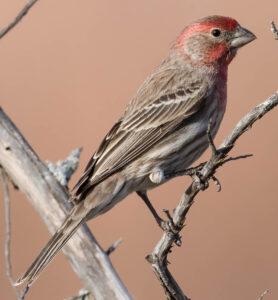
It should not be too long until birds bring their young to this feeder and bird bath. The House Finch young will be the most obvious. They will all look like their mothers but will be a bit messy, dishevelled. And they will beg from their parents right on the rim of the bird bath. A juvenile is showing begging behavior when it crouches down – its tummy will be almost on the rim of the bird bath. At the same time, the juvenile will tilt its head up and open its beak wide. While crouched low, it will flutter its wings. And often chirp and chirp and chirp. If the parents ignore the juveniles, the juveniles will hop right after their parents all around the rim, repeating this behavior over and over. Obviously, the juveniles have not grasped that this is NOT feeding time, but learning-to-take-a-bath time. Parents are persistent. Juveniles are not fed, but you will see the parents take baths right in front of them.
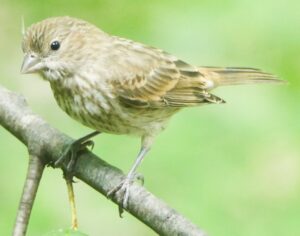
Juvenile House Finches do not instinctively know how to take a bath. They watch both parents and imitate their movements. You might see them practicing on the rim – some will go through an entire bath without ever getting in the water. Eventually all will venture in and once in, they all seem to love the water. Eventually juveniles and parents will all be in the bath together.
The Baltimore Oriole juveniles will be fairly easy to identify. They look more like their mothers but without any orange – mostly dull olive green and yellow. The catbird juveniles look exactly like both their parents except they are not as sleek and will look a bit messy. Generally, neither of these juveniles will exhibit the obvious begging behavior the House Finches show, but the juveniles will be tentative about their first baths. They quickly get over that and by summer’s end will enjoy a daily bath as much as their parents.
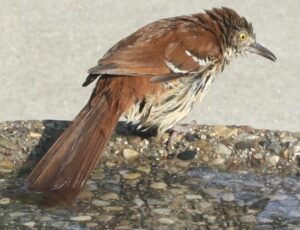
We have at least one pair of Brown Thrashers this year – in the last two years, we have had two pairs. But it seems there is only one pair this year and I think they are nesting in our large Witchhazel. I will not investigate as thrashers are much more skittish about everything than robins and that definitely includes us. I would not want a female to abandon her nest because I got too close. Both male and female are bathing in the bird bath every day. Most often by themselves, but yesterday late afternoon, they bathed together. If they do, you will be able to see the female is obviously smaller than the male – a bit shorter in length and not nearly as stocky. I have never noticed much difference in the size of male and female Brown Thrashers before – but this year there is an obvious difference.
The robin’s nest I have been following in the Public Forum looks like it will be successful. I would say the babies are a few days away from leaving the nest. You might see these juveniles at this bird bath – their parents use it every day.
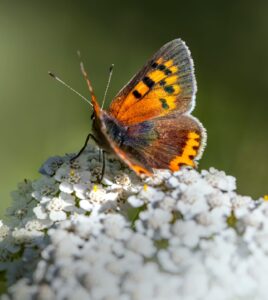
There is not a constant stream of birds at this bird bath or feeder but if you watch for 10 minutes or more at a time, you will almost always see a few birds. Other ones to watch for are Northern Cardinals, House Sparrows, Brown-headed Cowbirds, American Robins, Chipping Sparrows, Red-winged Blackbirds, and Indigo Buntings – males only right now. These birds are all coming daily – most often in early morning and from mid-afternoon on. But it is the Baltimore Orioles, Gray Catbirds, House Finches and robins who are the most frequent visitors.
This morning, I added more plants to the area close to the big bird bath. As the weeks go by, more and more flowers should bloom so there will be more color. Color not only attracts birds, it also attracts butterflies and moths. Sadly, we do not have many butterflies and moths. My guess is that is because we are in the middle of acres and acres of chemical agriculture. Many former hedge rows – which provided sources of nectar and egg-laying spots – have been removed so more corn and soybeans can be planted. Butterflies and moths are extremely sensitive to chemicals – both insecticides and herbicides. Our small lake and neighborhood are an oasis, but butterflies and moths have to fly over many acres of crops to get here. Although our neighbors have yards, there are not many flower gardens. And I do not know if our neighbors use chemicals on their lawns and shrubs. However, as summer progresses, we generally have a few swallowtails and a fair number of skippers. Often there is a monarch or 2. If any butterflies and moths are present in our flower gardens, I hope they will also use the flowers around the larger bird bath so you can also watch them.
Some time over the next few days, I will place a list in the Public Forum as to what I planted in the livestream viewing area of the bird bath.

